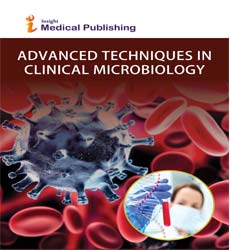Clostridium Innocuum, a Potential Emerging Pathogen with Microbiological and Clinical Characteristics
Kent Lewandrowski*
Departments of Pathology, Harvard Medical School, United States
- Corresponding Author:
- Kent Lewandrowski
Departments of Pathology
Harvard Medical School, United States
E-mail: kdrowski@gmail.com
Received Date: December 02, 2021; Accepted Date: December 16, 2021; Published Date: December 23, 2021
Citation: Lewandrowski K (2021) Clostridium Innocuum, a Potential Emerging Pathogen with Microbiological and Clinical Characteristics. Adv Tech Clin Microbiol. Vol.3 No.3:111
Copyright: © 2021 Lewandrowski K. This is an open-access article distributed under the terms of the Creative Commons Attribution License, which permits unrestricted use, distribution, and reproduction in any medium, provided the original author and source are credited.
Abstract
Clostridium innocuum is an anaerobic, gram-positive, spore-forming bacteria discovered in a patient with an appendiceal abscess by Smith and King in 1962. Its name, C. innocuum, reflected its clinically "harmless" nature, as evidenced by its lack of virulence in animal infection models. Since then, C. innocuum has been recognised as a normal component of the intestinal flora as well as the source of a rare, vancomycin-resistant opportunistic illness in immunocompromised people. C. innocuum, in addition to being a known extraintestinal pathogen, may also be a diarrheal pathogen that produces a C. difficile infection-like antibiotic-associated diarrheal sickness, according to findings from Taiwan. However, there are still unanswered questions about C. innocuum's clinical significance. We'll go through the microbiological and clinical aspects in this section.
Keywords
Clostridium difficile infection; Epidemiology; Gastrointestinal
Introduction
Antibiotic-associated diarrhea (AAD) is a highly common condition; antibiotics are given to almost half of all hospitalised patients, and up to 25% of those individuals develop AAD. While numerous infectious etiologies for AAD have been widely documented, such as Clostridium difficile infection (CDI), a new study from Taiwan identified Clostridium Innocuum (CI) as a previously unknown cause of AAD with multidrug resistance, even to vancomycin. In humans and a mouse intestinal model of infection, this study found that CI induces gastrointestinal illness that is indistinguishable from CDI, which can include severe and pseudomembranous colitis. In contrast to its previous designation as a clinically harmless intestinal commensal, CI is now recognised as having pathogenic potential [1]. This was based on a single study from 1962 that found no evidence of CI pathogenicity in a non-intestinal mouse model. Our preliminary clinical, microbiologic, and genomic data suggest that CI should be reclassified as an emerging pathogen. We recently isolated CI from more than 20 children with CDI (the contribution of CI to disease in these children is unknown) and one adult with recurrent AAD (in whom CI caused AAD). According to further investigation, many of these youngsters were colonised with C. difficile and had an unexplained diarrheal aetiology. Furthermore, several of our CI strains tested positive for C. Enzyme immunoassay of difficult toxins A/B (EIA) [2]. Thus, our first findings point to a paradigm in which some CI strains can create a protein that is recognised by C. difficile anti-toxin antibodies, and that CI can induce AAD in some individuals, possibly due to this unidentified protein.
Determine the clinical and molecular epidemiology of CI in symptomatic and asymptomatic adults and children to further characterise the epidemiologic importance and microbiologic characteristics of this emerging disease in US adults and children [3]. A/B toxin of Clostridium difficile Determine the relationship between this protein and CI pathogenicity (across-reactivity, and) Because vancomycin is being used more often for CDI in the United States, selective pressure may favour an increase in clinical infections caused by multidrug-resistant CI. Because C. difficile-specific diagnostic assays are widely used for CDI, diagnosing clinically indistinguishable CI AAD will necessitate significant changes in clinical microbiology practise [4]. For these reasons, it's critical to comprehend the magnitude of CI AAD in the United States. The proposed studies' successful completion will lead future research into the pathophysiology, diagnosis, and clinical aspects of CI infection. Our staff and the academic environment at Northwestern University have the abilities and resources needed to complete the proposed investigations, which include patient cohort assembly, microbiology, and bacterial pathogenesis [5].
Conclusion
Current clinical microbiology techniques are insufficient for diagnosing C. inoculum, and it is commonly misidentified. C. inoculum was first recognized as a virulent Gram-positive spore-forming rod. In immunocompromised individuals and/or patients with comorbidities, C. inoculum is a well-documented opportunistic pathogenic. C. inoculum, a vancomycin-resistant extra intestinal and diarrheal pathogen with clinical similarities to C. difficult, may be on the rise.
References
- Alexander CJ, Citron DM, Brazier JS, Goldstein EJ (1995) Identification and antimicrobial resistance patterns of clinical isolates of Clostridium clostridioforme, Clostridium innocuum and Clostridium ramosen compared with these of clinical isolates of Clostridium perfringens. J Clin Microbiol 33: 3209-15.
- Appelbaum PC, Spangler SK, Pankuch GA, Philippon A, Jacobs MR, et al. (1994) Characterization of a beta lactamase from Clostridium clostridioforme. J Antimicrob Chemother 33: 33-40.
- Brazier JS, Levett PN, Stannard AL, Phillips KD, Willis AT (1985) Antibiotic susceptibility of clinical isolates of Clostridia. J Antimicrob Chemother 15: 181-5.
- Brook I, Wexler HM, Goldstein EJC (2013) Antianaerobic antimicrobials: Spectrum and susceptibility testing. Clinical Microbilogical Reviews 25: 526-36.
- Rao S, Kupfer Y, Pagala M, Chapnick E, Tessler S (2011) Systemic absorption of oral vancomycin in patients with Clostridium infection. Scand J Infect Dis 43: 386-8.
Open Access Journals
- Aquaculture & Veterinary Science
- Chemistry & Chemical Sciences
- Clinical Sciences
- Engineering
- General Science
- Genetics & Molecular Biology
- Health Care & Nursing
- Immunology & Microbiology
- Materials Science
- Mathematics & Physics
- Medical Sciences
- Neurology & Psychiatry
- Oncology & Cancer Science
- Pharmaceutical Sciences
